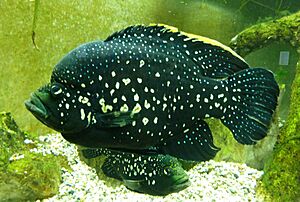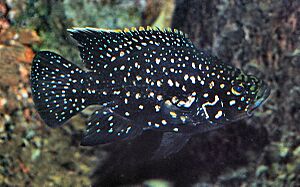Paratilapia polleni facts for kids
Quick facts for kids Paratilapia polleni |
|
|---|---|
 |
|
| Mature male P. polleni. Note the head hump, a common feature of dominant male cichlids. Behind him is a humpless individual, likely one of his mates | |
| Conservation status | |
| Scientific classification | |
| Synonyms | |
|
Paratilapia polleni is a cool fish from Madagascar, an island off the coast of Africa. It's a type of cichlid, which is a family of fish known for being smart and having interesting behaviors. This fish is found only in Madagascar, meaning it is endemic to that island. You might also hear it called the starry-night cichlid, polleni cichlid, or black diamond cichlid because of its beautiful spots. In Madagascar, people call it marakely, which means "black fish." This species is also popular to see in big public aquariums around the world!
The scientific name P. polleni honors François Pollen, a Dutch naturalist who collected the first known specimen of this fish.
Contents
What Does It Look Like?
P. polleni is a medium-sized fish with a body that is flat from side to side, like a pancake. This is called being laterally compressed. Like many cichlids, it looks a bit like a perch fish.
Adult male P. polleni can grow a fatty bump on their head, called a nuchal hump. This hump is usually a sign that the male is strong and dominant.
Colors and Size
Adult P. polleni are usually jet black. They are covered with bright, shiny spots that can look gold or blue. The color of these spots changes depending on how the fish moves and how the light hits it. This shimmering effect is called iridescent. Their eyes are a bright yellow.
Male fish can grow up to about 28 centimeters (11 inches) long. Females are usually about half that size. This makes it easier to tell males and females apart as they get older. Males also tend to have longer, sharper fins and a more rounded head. Even though females are smaller, many fish keepers think their colors are even more beautiful!
Two Kinds of Starry-Night Cichlids
For a while, scientists thought there was only one type of Paratilapia polleni. But then, people who raise these fish noticed that some had small spots and others had much larger spots. They also behaved differently and were different sizes.
After more study, scientists realized that the fish with the small spots was the original Paratilapia polleni. The fish with the large spots was actually a different species! This larger fish was given its own name: Paratilapia bleekeri. P. bleekeri can grow up to 30 centimeters (12 inches) long.
Where Do They Live and What Do They Do?
In the wild, P. polleni is a very adaptable fish. This means it can live in many different kinds of places. It can be found in rivers and streams in northern Madagascar. These fish can handle very cold water (as low as 12°C or 54°F) and even hot springs (up to 40°C or 104°F)!
What Do They Eat?
P. polleni is an omnivorous fish, meaning it eats both plants and animals. It also sometimes eats smaller fish. It's a sneaky hunter! It uses its dark color to hide and surprise smaller fish.
In an aquarium, people have seen P. polleni hunt by sneaking up on smaller fish from below, especially early in the morning. Then, it quickly opens its mouth, creating a "suction effect" that pulls the smaller fish right in. This clever way of hunting, using stealth and camouflage (called crypsis), helps it catch fish it might not otherwise be able to get.
In Madagascar, P. polleni is also caught and eaten by people. Like many cichlid fish in different parts of the world, it is known for tasting good!



